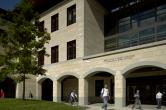Stanford Energy System Innovations (SESI)
SESI Resources |
|---|
| Book a Tour of the CEF |
| Energy and Climate Plan (2015) |
| Fact Sheet |
| FAQs |
| Technical Brochure |
| Technical Documentation |
| Industry Partners |
| Design Fly-Through Video |
| News Coverage |
Climate change caused by greenhouse gas emissions is the greatest environmental and socioeconomic challenge and opportunity of our time. Stanford has then accepted the challenge of our time and is raising the bar in efficiency to develop global solutions and implement them on campus.
Since the 1980s, Stanford has employed energy metering on all of its facilities to understand how and where energy is being used. For many years Stanford has employed best practices on both the supply and demand sides to reduce the cost and environmental impact of energy used to support the university mission of teaching, research, and public service. In October 2009, Stanford released a comprehensive and long-range Energy and Climate Action plan. Now in its third edition, the plan includes:
- High-efficiency standards for new buildings;
- continued efficiency improvements for existing buildings;
- and the cutting-edge energy supply system known as the Stanford Energy System Innovations (SESI) project.
SESI represents a transformation of university energy supply from 100 percent fossil-fuel-based combined heat and power plant to grid-sourced electricity and a more efficient electric heat recovery system. Although developed independently by Stanford from 2009 to 2011, SESI may be the first large-scale example in the world that employs the technology roadmap for building heating and cooling recommended by the International Energy Agency, which the United Nations Environment Programme also recently discussed in a comprehensive report for district-level implementation. This new system, along with Stanford’s solar power procurement, is anticipated to reduce campus emissions approximately 68% from current levels and save 15% of campus potable water. See remarks from Stanford University President John Hennessy at the new Central Energy Facility unveiling.
Conceived in the Department of Sustainability and Energy Management (SEM) and being implemented in collaboration with the Department of Project Management (DPM), the university architect’s office, Land Use and Environmental Planning, Zones Management, Buildings and Grounds Maintenance, and many other departments, the SESI program is an all-hands Land, Buildings & Real Estate engagement that will deliver immense benefits for Stanford University in decades to come.





